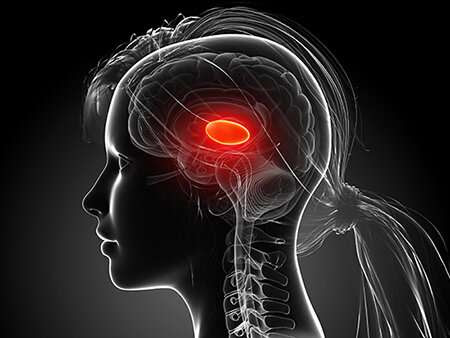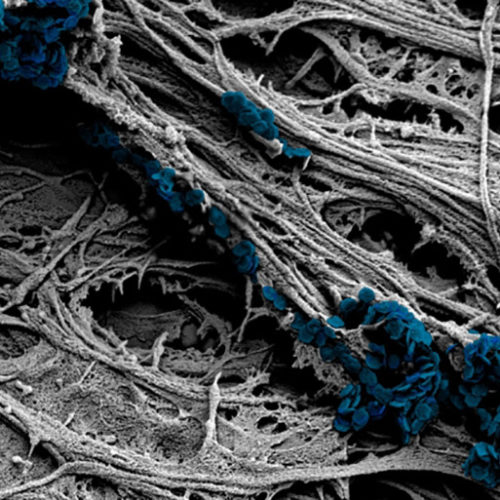by Flinders University You’re faced with a big decision so your second brain provides what’s normally referred to as “gut instinct,” but how did this sensation reach you before it was too late? The enteric nervous system (ENS) is an extensive network of neurons and transmitters wrapped in and around the human gut with the...
Tag: <span>Neurons</span>
Two distinct circuits drive inhibition in the sensory thalamus of the brain, study finds
by University of Alabama at Birmingham This research offers fundamental insights about sensory thalamic subnetworks and will enable powerful new strategies to probe behavioral and perceptual functions of these distinct circuits. Credit: UAB The thalamus is a “Grand Central Station” for sensory information coming to our brains. Almost every sight, sound, taste and touch we...
Calcium channel subunits play a major role in autistic disorders
by Universitaet Mainz After 21 days in vitro, hippocampal neurons of the rat form many synaptic contacts and communicate with each other. Within the study such neuronal networks cultivated on multi-electrode arrays were used to invest the synaptogenic function of α2δ-subunits. Credit: ill. by Artur Bikbaev The ability of the human brain to process and...
Mapping the brain’s sensory gatekeeper
by Massachusetts Institute of Technology Many people with autism experience sensory hypersensitivity, attention deficits, and sleep disruption. One brain region that has been implicated in these symptoms is the thalamic reticular nucleus (TRN), which is believed to act as a gatekeeper for sensory information flowing to the cortex. A team of researchers from MIT and...
The discovery of a ‘negative regulator’ in the brain alters understanding of brain function and potential treatment of cognitive disorders
The brain has an uncanny ability to enhance or reduce communication between brain cells. Whether or not communication is fast or slow changes the brain’s overall function. Understanding how these cells communicate within the brain is critical to understanding how our bodies and minds work together. Terunaga Nakagawa, associate professor of molecular physiology and biophysics,...
Mechanically Stimulating Neurons Using Magnetic Nanodiscs
Electrical stimulation and chemical pharmaceuticals are the two ways that doctors and scientists routinely use to manipulate neural cells. Chemicals have their side effects, are slow to take effect, and are usually systemically delivered, while electrical stimulation usually requires invasive wires, is limited in its resolution, and is nearly impossible to administer within certain parts...
Study points to potential new approach to treating glaucoma and Alzheimer’s disease
by Bill Snyder, Vanderbilt University Medical Center Researchers at Vanderbilt University Medical Center (VUMC) have shown for the first time that when one optic nerve in the eye is damaged, as in glaucoma, the opposite optic nerve comes to the rescue by sharing its metabolic energy. In doing so, however, the undamaged optic nerve becomes...
Study helps to settle debate on roles of REM and non-REM sleep in visual learning
by Kerry Benson, Brown University This is a screenshot of a polysomnographic record (30 seconds) representing Rapid Eye Movement Sleep. EEG highlighted by red box. Eye movements highlighted by red line. Credit: MrSandman/ Wikipedia Which sleep stage is most important for learning: REM or non-REM? Does sleep improve learning by enhancing skills while people snooze,...
Restoring mobility by identifying the neurons that make it possible
ECOLE POLYTECHNIQUE FÉDÉRALE DE LAUSANNE Researchers at EPFL are able to get paralyzed rodents walking again by stimulating the animals’ damaged spinal cords. This promising treatment has already helped paraplegics regain mobility during clinical trials at Lausanne University Hospital (CHUV). Now, using artificial intelligence, the researchers can pinpoint which neurons are involved in the gait...
Genetic editing milestone in mouse model of Rett Syndrome
Editing technique repairs mutant MeCP2 RNA and restores MeCP2 protein function RETT SYNDROME RESEARCH TRUST LEAD AUTHOR, JOHN SINNAMON, AND PRINCIPAL INVESTIGATOR, GAIL MANDEL. view more CREDIT: RETT SYNDROME RESEARCH TRUST A genomic error that causes Rett Syndrome, a serious lifelong neurological disorder, can be corrected in the brains of mice by rewriting the genetic...






